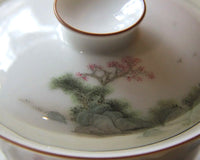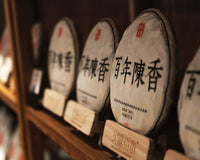The making of green tea has one goal: to return freshness back to the picked and processed leaf. It is no easy task, and is only achieved using the addition of heat and the efforts of a skilled tea maker.
Left to dry naturally, freshly-picked tea leaves gradually oxidise. In white tea, this process is desired; oxidation creates complex and colourful compounds chemically distant from those found in the plant, and the flavour of white tea is developed as a result. Green tea production, on the other hand, aims to seal freshness into the processed leaves and preserve large numbers of leaf compounds in their original form. For this reason, no other tea type can evoke the fresh and invigorating airs of spring as persuasively as green tea.
Green Tea Production Processes
Green teas are made in a three-stage process of fixation, rolling or shaping, and drying. In practice, the majority of green teas also include a shallow or brief withering period before fixation. In any case, the critical stage of green tea production is fixation, or, to use the idiomatic Chinese phrase, 'Kill Green'. It is in this stage that oxidation is prevented so that colour and tasting quality are fixed. Contrary to what the above-mentioned idiomatic Chinese term 'Kill Green' may suggest, the colour 'green' isn't killed, but rather the enzymes within the leave that cause browning.

An experienced tea maker, by using their hands, can feel the change in the green leaf during the fixation process. Zhejiang province, China.
Understanding green tea through its classification as an un-oxidised tea is a modern interpretation; for much of the past two thousand years of recorded tea history, neither colour nor manufacture defined teas.
Exposing leaves to heat rather than light was arguably the most important innovation in the development of tea making. Before the use of high temperatures to treat leaves, natural drying methods, such as shade-drying techniques, were used to prepare traditional Chinese medicines.
Using extra heat accelerates the drying process quickly enough to preserve more fresh-leaf compounds. On the leaf surface, high temperatures speed up the dehydration of the leaves. By removing moisture, leaves can be stored for future use. Applying heat directly to the leaves after picking - or at least before significant chemical change can occur - also preserves the natural colouring of the leaves.
The biochemistry of green tea production paints a more detailed and nuanced picture. Fixing has two main purposes: one 'suppressive', another 'expressive'. On the one hand, heat prevents the oxidation of polyphenols; on the other, it speeds up the breakdown of compounds - proteins and sugars - that enhance the sweet and refreshing flavours and vapours.
Exposing leaves to high temperatures does not cause any dramatic chemical change; it does, however, subtly rearrange the chemical balance.
Seen in this way, fixation is not merely drying or deactivating enzymes. It is a delicately poised process; the tender picking standard of green teas, sometimes composed only of juicy buds, are saturated with water and highly active enzymes, both of which heighten the risk of oxidation.
This picking standard complicates fixation: the more tender the pick, the easier it spoils; this juiciest part of the tea plant requires a deeper (longer and hotter) fixation - physically immature and less fibrous, these tender picks are easier to manipulate, accounting for the diverse shapes of green teas.
Heat is the instrument of fixation. In the factory, it is a dynamic phase that requires the skilled application of heat on tender leaves and buds. The tender picking standard of high calibre green teas - bud-only or one leaf, one bud - contains highly active enzymes and high water content.
The tender and juicy picked leaf used to make green teas is acutely vulnerable to spoiling. For a maker of green tea, fixation is the decisive influence she or he can have on the final quality. It is a highly refined art of tea making that has also been, to an extent, successfully mechanised.
High-quality, handmade green teas benefit from the personal expression of tea makers and the subtle finessing of leaf shape; machine-made green teas have replaced this expressive quality and expanded the scale of green tea production.
Success in fixation produces bright, unblemished leaves, sparkling liquors with only fleeting bitterness or astringency, and strong, fresh aromas. Fixation can make or break the quality of the finished tea.











